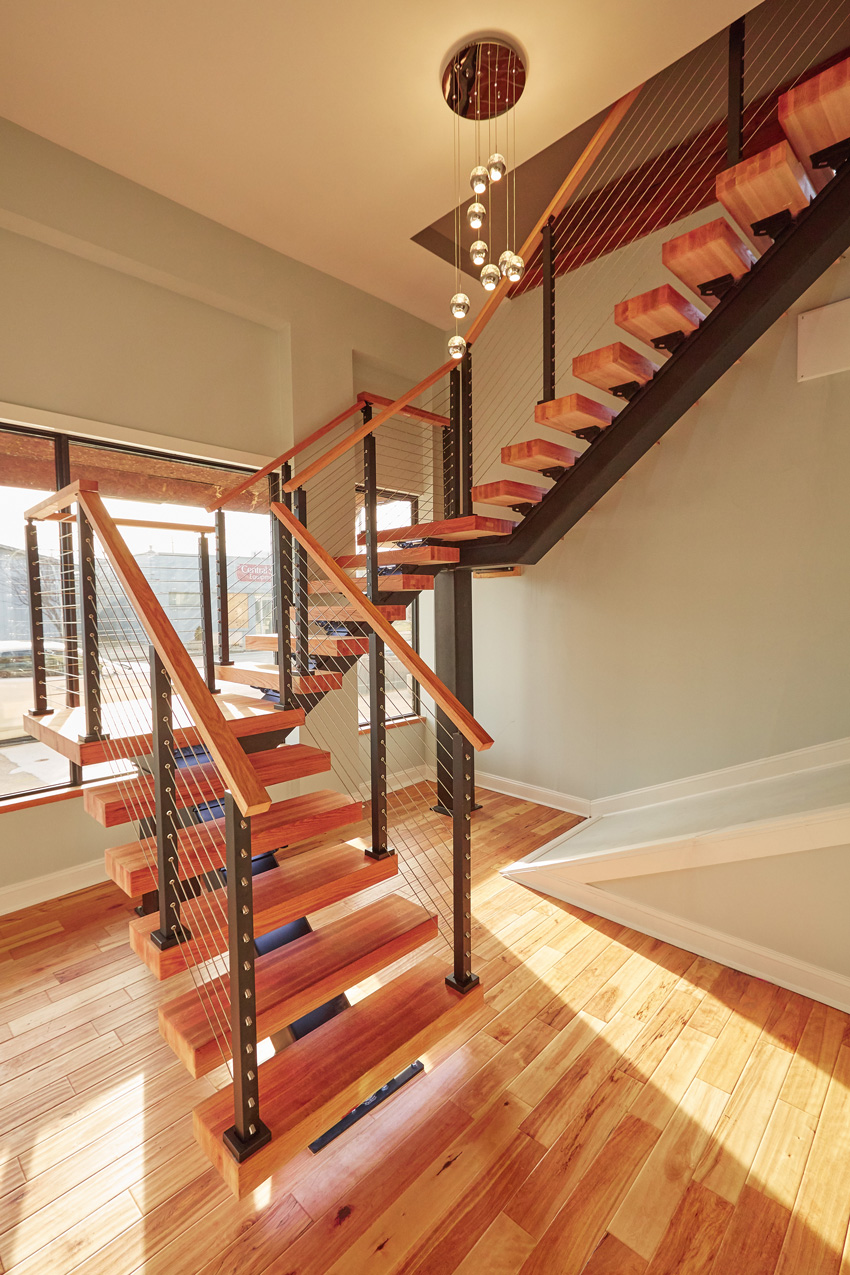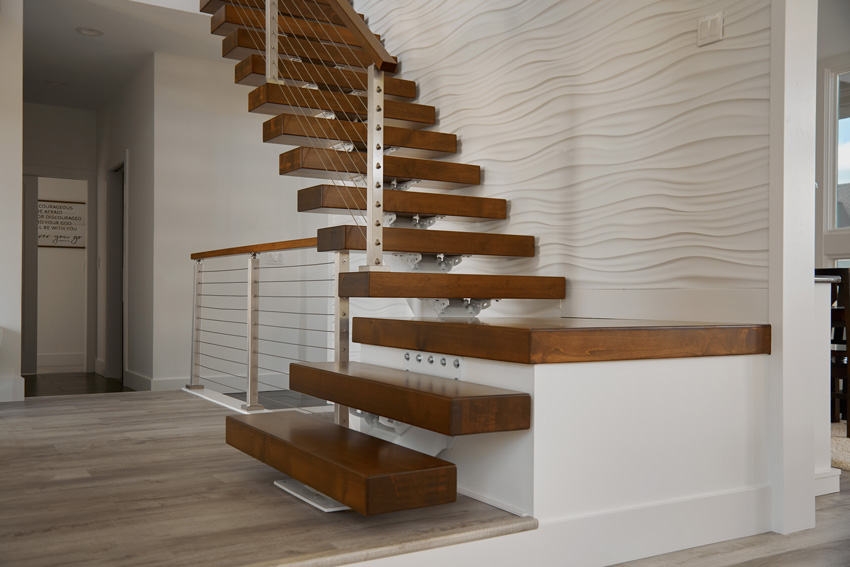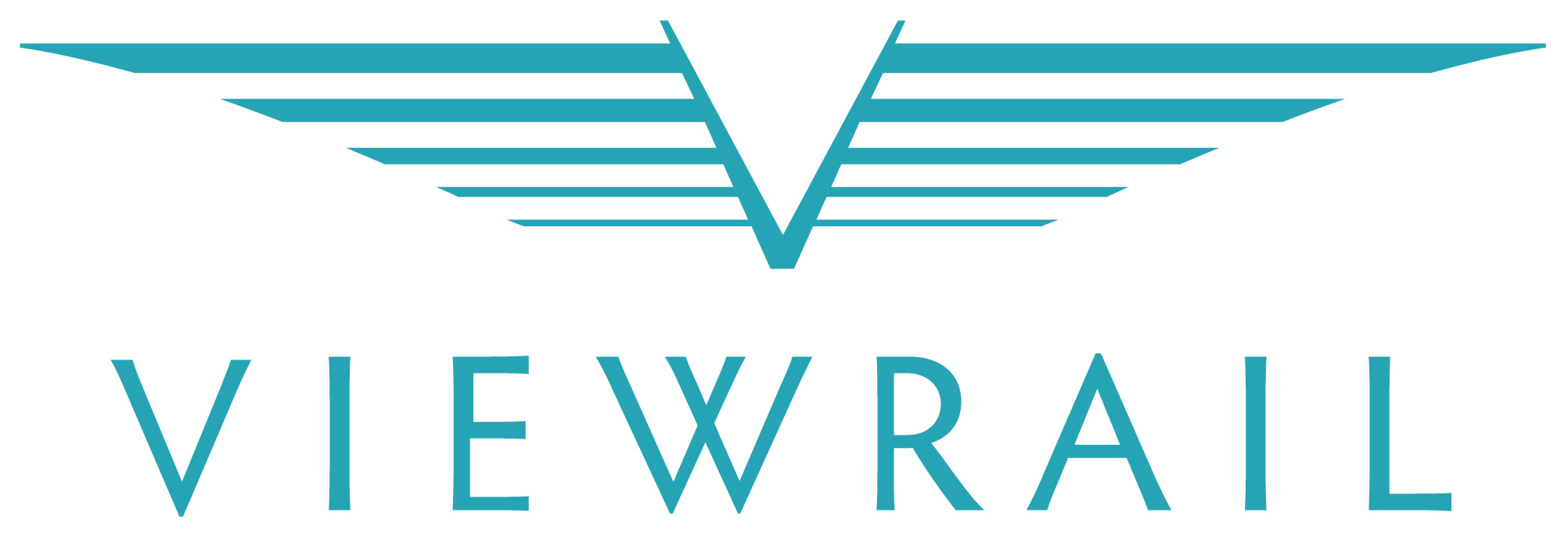This CE Center article is no longer eligible for receiving credits.
Straightforward Design Process
In many cases, the design process of a floating staircase begins with dimensions. Once the dimensions of the project have been provided, a designer will often work with an internal support team to identify the necessary measurements of the staircase and select the stringer, treads, and railing system that will provide the desired aesthetic.
Precise Development Process
Once the design of the floating staircase has been finalized and the quote has been accepted, the engineering process begins. Detailed shop drawings of the floating staircase will be developed that illustrate the precise dimensions of the staircase and any customization that has been requested. Once these shop drawings are approved, the production crew will begin cutting, welding, and powder coating the stringers, and carefully crafting each tread.
Quick Delivery
Some manufacturers can deliver a floating stair system in as little as six weeks from the time that production begins.
Easy Installation
“The two most common questions I get from designers, once they have seen the floating staircases, are ‘How is it installed?’ and ‘How much does it cost?’” explains Fernando Sainz, president of sales and co-owner of Viewrail. “The staircases are beautiful, but the thing that impresses designers is how quickly they can be installed. Contractors and builders are installing these floating staircases in as little as one day. It’s incredibly fast and it means that architects can add these modern architectural elements without negatively impacting the completion date of the project.”

The installation of a floating staircase can be completed in one day, and contractors have the flexibility to install the system during rough-in or the finished stage of the project.
Ease of installation is one of the key differentiators between various floating staircase providers. Some manufacturers have streamlined the process so that a floating staircase can be installed in a day. These systems arrive to the job site pre-welded, prefabricated, and ready for installation.
Here is a basic installation overview. The mono stringer has attachment plates on either end to serve as attachment points for the top and bottom of the staircase. Once the stringer is in position, the individual brackets are installed onto the stringer. Then the treads, which have been precisely routed out to accept the brackets, are placed onto the brackets and secured.
Once the treads have been installed into the staircase, it’s time to install the railing system. The posts can be mounted on top of the treads or attached to the sides of the treads. The handrail is secured onto the posts, and the cable or rod infill systems are pulled horizontally from one post to the next.
These systems also offer flexibility in terms of when the staircase can be installed. As soon as the joists go up on the building or house, these staircases can be installed and used as construction stairs. They are also engineered to be able to be the last item installed on the project. This enables the contractors and builders to fit the staircase into the project whenever it makes the most sense.
Overall Cost
Companies that manufacture floating staircases offer designers a more cost-effective solution because they have the experience, processes, and equipment to make their design, manufacturing, delivery, and installation smooth and issue free. The components are manufactured with specialized tooling in a factory designed, outfitted, and staffed with craftsmen and craftswomen specifically trained to create floating stairs. Owners and AEC teams will realize time and cost benefits of working with an organization that has already identified potential design and manufacturing issues and resolved them before the order is placed. The streamlined and simple installation process also safeguards project timelines and budgets, enabling contractors to install beautiful and dramatic staircases without exposing themselves to costly setbacks.
Available Customization
While floating staircase manufacturers have streamlined much of the design and production aspects of a typical modern staircase, nearly every characteristic of a floating staircase is customizable. Designers may choose a floating staircase solution even for projects with unique dimensions, site constraints, or client preferences.
Conclusion
A floating staircase can offer designers a modern and dramatic architectural element that does not monopolize a lot of interior square footage. Interestingly, these staircases are designed to be both seen and not seen. They are constructed from beautiful materials in eye-catching designs while delivering a modern, minimalist aesthetic that enables them to support open-space layouts and visually connect areas on either side of the staircase. The stairs also create unique vantage points from which people in the space can admire the interior.
Fortunately, the work that manufacturers have done to streamline the design, production, and installation processes enables these solutions to enhance the beauty of a space without breaking the budget. Designers may be surprised to learn that floating staircases purchased from a manufacturer can be half the cost of a similar staircase that will be built on-site. They also arrive prepared and packaged in a way that is easy to install, which saves timelines and keeps installed costs low. Consider incorporating a floating staircase into a commercial or residential interior, instead of nestling the conventional wood risers and treads behind drywall, and introduce clients and their guests to a heightened experience when climbing the stairs.
Jeanette Fitzgerald Pitts has written nearly 100 continuing education courses exploring the benefits of incorporating new building products, systems, and processes into project design and development.
There is a common misconception in the marketplace that dramatic, beautiful, and unique staircases must be expensive, time intensive, and complicated to incorporate into an interior. While, historically, staircases of note have been large, sweeping, architectural wonders constructed in marble or mahogany, today, contemporary design demands interiors that are streamlined and stripped back, so staircases have been revamped and redesigned to contribute to this minimalistic aesthetic. In the process, manufacturers created modern staircase solutions that could offer a simplified design process, be produced quickly, feature stunning materials, and be easily installed in as little as one day. The result of these streamlining and engineering efforts is a new type of modern staircase that satisfies mid-market project budgets in the commercial and residential space and offers a more attractive alternative to the concrete or drywall-encased stairways that so often find themselves hidden on the perimeter of a building.
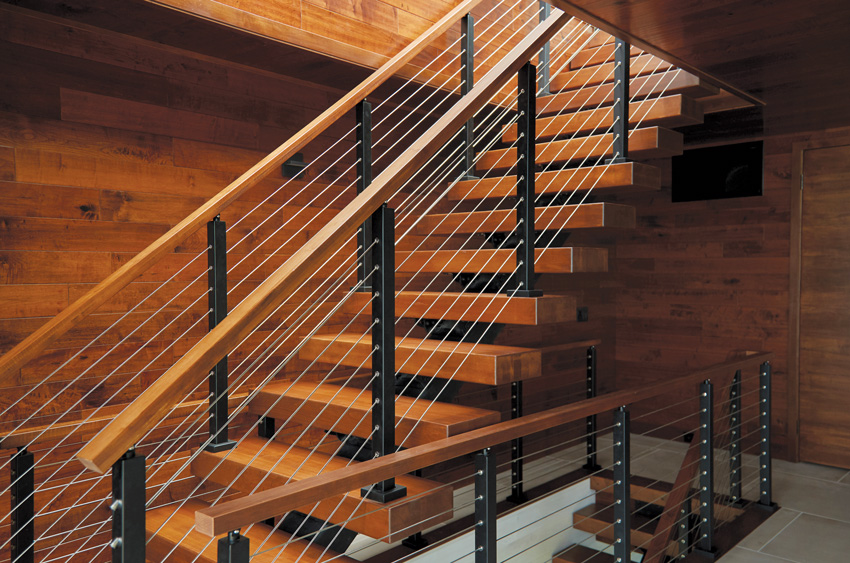
All photos courtesy of Viewrail
“In the past, it has taken us weeks to months to pull together a stair system as elegant as this one,” says Lowell Smith of Dunes Development. “On the first flight of stairs, we had a bit of a learning curve, and it took us all of two days. We installed the second flight of floating stairs in one day.”
This new type of modern staircase creates drama and visual interest with air and openness and features a footprint so small, and structural supports that are so hidden, that the element practically floats in the space, which may explain how it came to be named a floating staircase.
The Anatomy of a Floating Staircase
A floating staircase is, essentially, an aesthetically deconstructed staircase, where the extraneous parts and pieces have been removed to reveal the basic components a staircase must possess to enable people to climb and descend safely throughout a space. The entire floating stair system is comprised of four key elements: a mono stringer, treads, brackets, and the railing system.
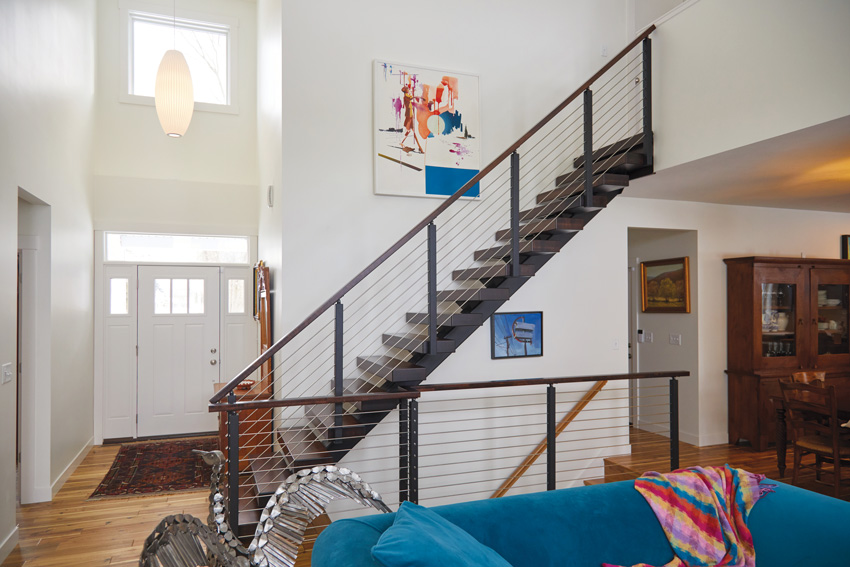
Floating staircases are modern solutions that can be produced quickly, installed in as little as one day, and feature stunning materials.
Instead of using two stringers to support the staircase on its right and left sides, which is the approach most commonly found in commercial and residential construction today, a floating staircase uses a single, central stringer for the necessary support. This type of stringer is referred to as a mono stringer. The mono stringer is a heavy-duty, mild steel tube that serves as the central beam running underneath the stairs from the top to the bottom of the staircase. One mono stringer supports one flight of stairs.
The use of one central stringer, instead of two stringers that flank the length of the staircase, eliminates the need for many of the finishing elements that are typically used to make the more visible stringers running alongside each staircase more aesthetically appealing. For example, a floating staircase does not need stringer fascia, the finished inside vertical surface of the stringer, or stringer capping, the finished surface that runs along the top of the stringer.
The treads are the horizontal surfaces of the stair, which provide the surface on which people step as they go up and down. Traditionally, stairs have been constructed with treads providing horizontal surfaces and risers providing the vertical surface between each tread. The tread-riser-tread-riser-tread-riser configuration creates that completed ribbon appearance that most stairs possess. Floating staircases do not include risers, allowing each tread to stand alone and enabling space, air, and view to travel through and around the staircase. Each tread is then fastened securely to the mono stringer with a bracket.
The last component of the floating staircase is the railing system. The railing system is constructed of the handrail, posts, and infill. The handrail is the part of the railing system that a person holds as while walking up or down a stair. The posts are the vertical structures that connect the handrail to the staircase and provide the support necessary to withstand the lateral force applied to the handrail when a person uses it. In a floating staircase, the posts are installed either directly into the treads or attached to the side of them. The infill is the material that fills in the open space between the posts and the treads and the handrail, creating a safety barrier along the staircase.
Railing systems have been built from a variety of materials over the years and constructed with varying degrees of detail, depending upon the application. The most distinguishing factor about the infills used in floating staircases is that, while meeting safety requirements, they offer an incredible openness that allows light and views to travel unobstructed throughout an interior. Commonly constructed from cables, rods, or glass, these materials create beautiful, effective, and modern railing systems that do not have visual barriers that break up a room.
The Aesthetic Difference: Floating vs. Conventional
The combination of the mono stringer, stand-alone treads, brackets, and transparent railing system used in the floating staircase creates a minimal and modern aesthetic that is dramatically different from the fully encased appearance so often created with conventional staircases. Conventional staircases are regularly designed to appear as if they are nestled into the larger building.

Floating staircases do not include risers, which allows light and view to travel through and around the dramatic structure.
This may have occurred as a result of the types of materials commonly being used to build the staircases and not because it creates optimal staircases.
In a typical construction project designed with typical staircases, the stringers, treads, and risers are made from the same plywood or lumber used to create the frame of the structure. When the stringers, treads, and risers are made from these lower-quality materials, they need to be covered up to make way for the desired aesthetic that will be created in the space. Just as drywall is used to cover up the wooden studs in the frame, the two unsightly stringers providing a border on either side of the staircase and the wood treads and risers must be camouflaged or finished. Contractors will often hide the lackluster materials used in stair construction by building up walls underneath the stairs with drywall so that visitors in the space never see the underside of the stairs. Then carpet or hardwood trim is applied to the top of the stairs to finish them.
Unfortunately, creating interior walls for the sole purpose of hiding the materials in a staircase has many undesirable results. It creates a staircase with a footprint that is much larger than it needs to be. The solid wall camouflage also breaks up the room unnecessarily and contradicts the minimalist, open-area aesthetic that is becoming so popular in commercial and residential spaces.
The floating staircase strips the staircase elements back to the necessities and then uses beautiful, high-quality materials to build them. Instead of stringers, treads, and risers made from plywood or framing lumber, a floating staircase is constructed with a powder-coated steel stringer, which is hidden beneath the treads, and thick wood treads in several on-trend and inspiring colors and finishes. There are no risers, and the railing systems are minimalistic and high quality as well, keeping stair users safe.
Floating stairs can be incorporated into a floorplan without creating a visual or physical obstruction in the space and requiring a fraction of the footprint consumed by more conventional drywalled staircases. The high-quality and beautiful materials do not require camouflage or extra structures to hide. People can see and walk under the stairs without losing contact with the larger room.
Floating stairs also create a dramatic and safe experience for people walking up and down the staircase. The hidden mono stringer and the elimination of the risers creates stairs that are more open than anything seen conventionally. The openness and connection to the larger space offered by floating stairs is certainly thrilling to experience, while being just as safe as the more hemmed-in staircase solutions.
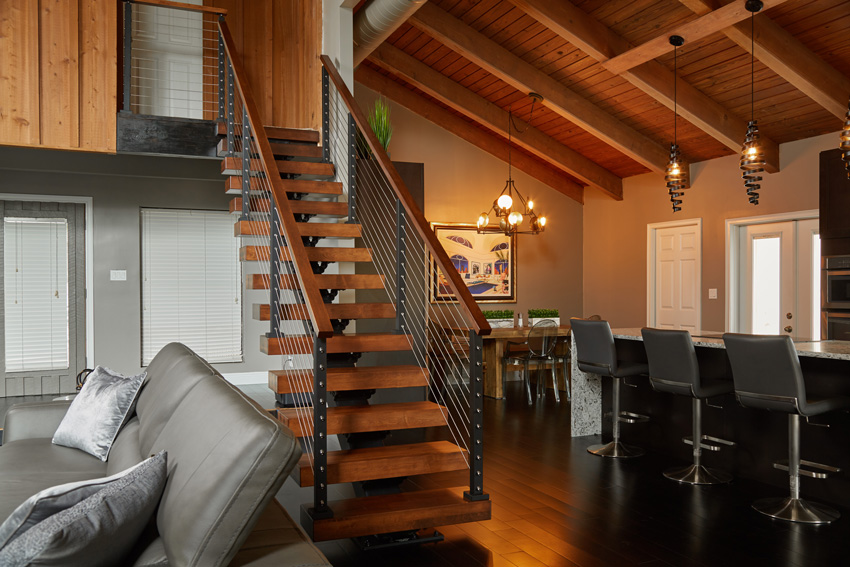
“Floating staircases are architecturally beautiful, and they give me a unique square-footage in a space that I wouldn’t otherwise have,” explains Brian Ellison, owner of Brian Ellison Designs in Melbourne, Florida.
“I create a lot of Miami-modern interiors. Floating staircases are architecturally beautiful, and they give me a unique square-footage in a space that I wouldn’t otherwise have,” says Brian Ellison, owner of Brian Ellison Designs in Melbourne, Florida. “These staircases elevate the environment, and going up and down the staircase is exciting. It does create a moment.”
Aesthetic Options
Unlike the conventional staircases made of framing materials that demand to be covered up or camouflaged, a floating staircase is designed to be looked at from every angle and touched. The stringers, treads, and railings are constructed from high-quality materials in on-trend colors and finishes. Designers can choose from several options to create the floating staircase that perfectly complements any interior decor. The floating staircase also creates a unique experience for people using the stairs, redefining the feeling of moving from one level to another.
Mono Stringer
The mono stringer serves as the structural backbone for the entire floating staircase. Although its view is partially obscured from some angles by the treads installed upon it, the powder-coated mono stringer is available in more than 15 colors, including the most popular: black, silver, and white.
Treads
The treads in a floating staircase are the centerpiece of the design. They are thick, beautiful pieces of wood that create an impression when they are seen and walked upon. They look substantial and stylish. They feel smooth and sturdy.
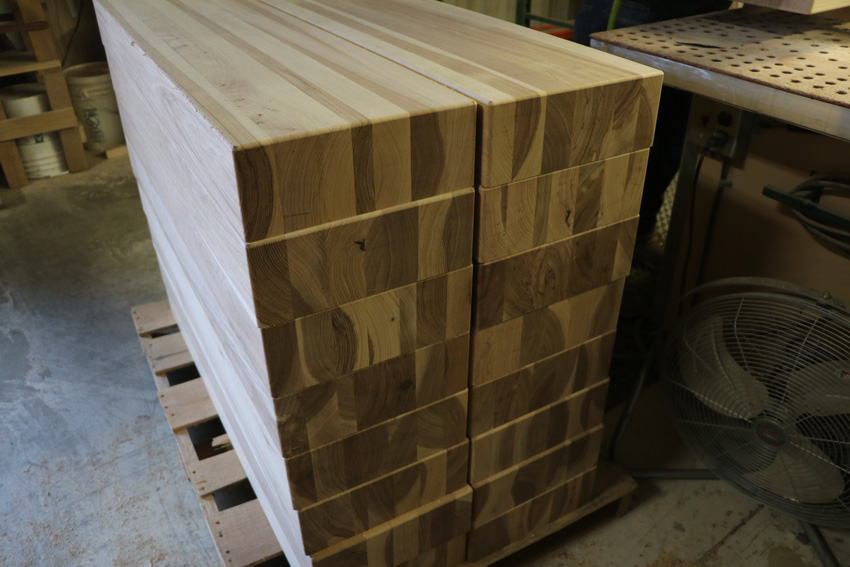
Treads that are 31⁄2 inches thick are also referred to as butcher-block style treads, and they make a substantial impression when incorporated into a staircase in a commercial or residential project.
When selecting a tread for a floating staircase, there are four different qualities of the tread that must be defined: the type of wood, the stain of the wood, the thickness of the treads, and whether the treads should be finished in a traditional, distressed, or hand-scraped style.
Treads can be found in a variety of wood types that offer different levels of variability within the grain pattern and strength. Both white oak and red oak are highly recommended for floating stair designs. White oak contains a lot of movement in its grain pattern that makes it easy to hide wear, and the level of variation has been found to pair nicely with natural hardwood flooring and design accents. If a designer is looking for a floating staircase that is a bit more uniform from one step to the next, consider hard maple. Other popular wood types used as treads in floating staircases include walnut, American cherry, Brazilian cherry, hickory, and ash.
Once the type of wood has been selected, designers may choose from several stains to develop the color of the tread. The wood can be stained clear, something that would add more of a honey-colored tone to the wood, a richer chocolate, a deep red, or even an antique grey.
Then the thickness of the tread must be specified. A typical, standard stairway has treads that are 11⁄2 inches thick. Floating staircases commonly feature treads that are 31⁄2 inches thick, also referred to as butcher-block style treads. These treads are heavy and substantial both visually and when they are felt underfoot.
Finally, some manufacturers offer treads that can be given a more lived-in look with a distressed or hand-scraped aesthetic.
Brackets
Brackets and the aesthetic impact they have on the completed staircase are an interesting point of differentiation between various floating stair providers. As a reminder, the brackets are used to hold and secure the treads to the mono stringer that runs underneath them from the top of the staircase to the bottom. Typically, these brackets are quite large and visually obtrusive. Some systems use a plate that covers most of the bottom-side of the tread’s beautiful wood surface or incorporate V-shaped structures that overwhelm the tread its supporting. The presence of these large brackets or plates gives the underside of the floating staircase a hardware-heavy look, which is not ideal.
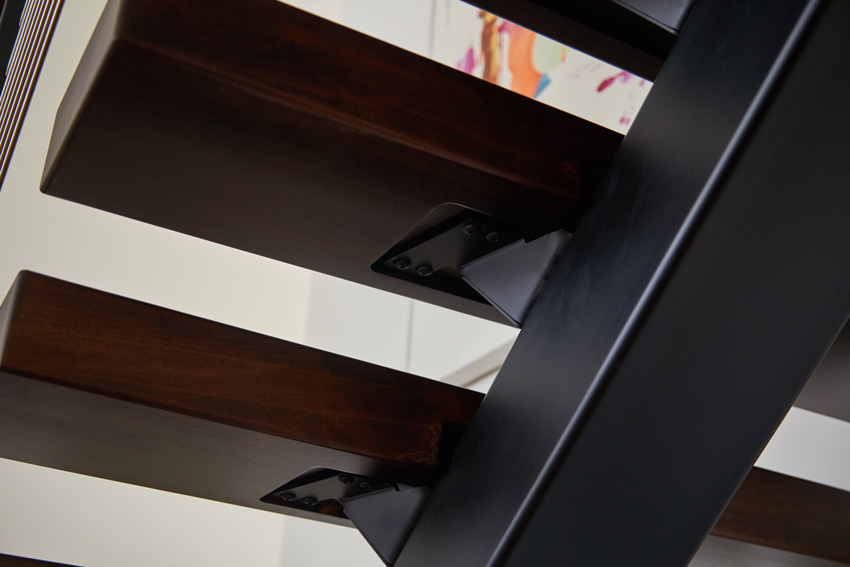
From this vantage point, looking up from under a floating staircase, a viewer can see the amount of surface space covered by the smallest, least-obtrusive brackets in the industry.
New brackets have been developed that are a fraction of the size of their predecessors and are all but invisible. When people walk underneath a floating staircase that uses these smaller brackets, the wood tread is still the visual star. The development of smaller, less-obtrusive bracket technology improves the overall floating aesthetic that these staircases deliver into an interior.
Railing System
The railing system consists of posts, handrails, and infill that fill in the open space on either side of the floating stair system. The posts are available in stainless steel, aluminum, and several power-coated finishes. The handrails can be wood, matching the color and style of the treads, or aluminum or stainless-steel handrails can be selected. The infill materials can be cables or rods that run horizontally, parallel with the handrail, or they can be glass.
Popular Combinations
With all the tread options in wood types, thicknesses, and finishes, mono stringer colors, and railing systems, there are countless combinations of floating staircases available to make the perfect modern addition to any interior. Interestingly, from the sea of possibilities, a few trends are emerging in terms of the way that tread colors are being selected to complement the interior decor and new textures that take the experience of the floating staircase to the next level.
In the past, it was common to match the treads to the predominant interior color, so, for example, lighter floors would be complemented with lighter-colored wood treads. Now the trend seems to be in creating contrast. Designers working on interiors with lighter floors are selecting floating staircases with darker wood treads to make the element even more dramatic.
Manufacturers are also now offering scraped finishes that offer a touch and feel that is different underfoot from the traditional smooth and flat finish. The texture adds character to the journey up and down the stairs. These distressed or hand-scraped details provide the added benefit of camouflaging wear and tear on the stair tread.
The Functional Details of Floating Staircases: Codes and Configurations
Depending upon the needs of the project, staircases can be designed to be bold and dramatic or hidden and unremarkable, but, regardless of their aesthetic qualities, there are two properties that any staircase must possess. It must be compliant with the applicable codes and regulations, and it must enable people to travel from one floor to another in a way that fits the available space. Although they may look quite different from conventional staircases, floating staircases are code compliant, safe, and available in several configurations.
Code-Compliant Features
The International Building Code (IBC) and the International Residential Code (IRC) contain a few design and performance criteria that must be satisfied to ensure that the floating staircase is code compliant. Generally speaking, these codes outline acceptable run lengths and rise heights for each tread and riser in the staircase, depending upon whether it is in a commercial or residential setting. They also provide requirements defining an acceptable stair width, the size of the load that the treads and handrails should be able to support, and the infill and handrail requirements in terms of acceptable heights, widths, and spacing.
Most of the code requirements are the same for floating staircases and conventional staircases, with one notable difference. Conventional staircases include a vertical riser in-between each tread. This is referred to as a closed-riser design. The IBC allows a staircase with a closed-riser design to have a rise, which is the vertical height between two adjacent steps, up to a maximum of 7 inches high. A floating staircase does not include a riser between each tread and, instead, features an open gap. The IBC requires that the open gap between each tread not exceed a maximum of 4 inches. This aligns with the rule for the railing infill, commonly referred to as the 4-inch sphere rule, where the railing system must be designed so that a 4-inch sphere cannot pass through any portion of the railing. This rule was created to prevent small children from passing through the railing system or through the gap between the treads and hurting themselves.
Here is a high-level overview of some of the design guidelines that floating staircases in commercial buildings must satisfy to be compliant with the IBC. For the actual criteria that apply to a specific staircase on a project, please refer to the authority having jurisdiction.
- The open gap between the treads cannot exceed 4 inches.
- The stair tread depth should be a minimum of 11 inches on commercial applications.
- Each step must be able to bear at least a 300-pound concentrated load.
- Spindles or cables in the guardrail system should not be placed more than 4 inches apart.
- Handrails should not be less than 36 inches in height.
- Guardrail systems must be capable of withstanding, without failure, a lateral force of at least 200 pounds applied in a downward and outward direction within 2 inches of the top edge at any point along the top rail.
Floating Stair Configurations
Floating staircases are available in several configurations, giving designers options for incorporating these modern elements in a way that best suits the layout of the space and the floor-to-floor height of the project. Currently, floating staircases are commonly offered in straight, L-shaped, and switchback forms. Custom projects can also be explored for spaces with unique demands.
Straight Staircase
A straight staircase describes a staircase with the simplest silhouette. It runs from the bottom to the top in one straight slope on top of one mono stringer. This type of staircase does not change direction, and no additional intermediate supports are required to further prop it up. If the overall vertical height of the staircase is less than 12 feet, then no landing is required.
L-Shaped or 90-Degree Staircase
An L-shaped staircase describes a straight stair with a bend in it. This type of stair is also referred to as a 90-degree staircase or, less commonly, a quarter-turn stair. The staircase can turn either to the left or the right, and the change in direction is typically accomplished by incorporating a landing at the point of transition. The landing can be positioned in the middle of the staircase so that both flights of stairs are the same length, or the landing can be located closer to the bottom or the top of the stairs. When the landing is closer to the bottom or the top, this configuration is sometimes referred to as a long L-stair.
Switchback Staircase
A switchback staircase, also referred to as U-shaped stairs or half-turn stairs, is the most compact staircase design option. A person climbs the first flight of stairs, arrives at the landing, and turns 180 degrees to climb the second flight of stairs. This double-back shape allows designers to achieve the greatest heights in the smallest footprint. Floating stairs in a switchback configuration can be wall-mounted on the perimeter of the room, or they can be positioned as a centerpiece in a space with their stand-alone, steel-column-supported platforms.
Choosing a Floating Stair Provider
Once an architect has identified that a floating staircase should be incorporated into a project, there are two types of providers that the designer can work with to get the staircase designed, produced, and delivered to the project. The general contractor, or a sub-contractor, will typically be responsible for the installation of the staircase at the job site. Architects can choose to work with a local metal fabricator to design and produce the staircase, or they can choose a solution from a company that engineers floating stair systems. This choice has significant implications on the design process, as well as the production and installation timelines, and, ultimately, the overall cost of the staircase.
While a local metal fabricator certainly can deliver a beautiful floating staircase, there are many limitations that can dramatically slow the design and fabrication of the product when this type of provider is used. In addition, the installation of staircases provided by a local metal fabricator can be complex and involved. When sourced locally, it is typical for some welding to be done on-site, which can be virtually impossible in a remodeling project and awkward in new construction, depending upon when the installation of the staircase takes place. It can easily take days or weeks to configure and create a floating stairway on-site with a local metal fabricator. The crux of the issue is that a local metal fabricator will approach every project as if it is a custom and unique job because, in fact, it is. This means that each design starts from scratch. The stringer, brackets, treads, and railing system are built specifically for this one client, this one job.
Benefits of Working with a Floating Stair Company
Companies that engineer floating stair systems have streamlined the design, development, and delivery of these modern staircases so that designers can receive beautiful, code-compliant products quickly. They have experienced staff and catalogues of job examples to reference when helping a designer select the best floating staircase for a project. These companies have eliminated the guesswork and potential errors from the design process and tweaked the components and manufacturing processes so that everything fits together as it should, every time.
Beyond getting a beautiful, high-quality product more quickly, these companies can deliver the staircase in a way that makes it much faster and easier for the contractor to install. In many cases, contractors can complete the installation in one day with a crew of three carpenters. No special skills are required, and the installation can occur during the rough-in or the finished stage of the new construction or remodeling project.
When working with a company that engineers floating staircases, ease of installation is a critical part of the whole package. The company has spent time and money to develop a process and the supporting materials that general contractors everywhere can use to easily and successfully install their floating staircases. When working with a local metal fabricator, the process and delivery is oftentimes more piecemeal, and the installation can be less organized and a little more haphazard because the delivery process has not been fine-tuned or standardized.
Straightforward Design Process
In many cases, the design process of a floating staircase begins with dimensions. Once the dimensions of the project have been provided, a designer will often work with an internal support team to identify the necessary measurements of the staircase and select the stringer, treads, and railing system that will provide the desired aesthetic.
Precise Development Process
Once the design of the floating staircase has been finalized and the quote has been accepted, the engineering process begins. Detailed shop drawings of the floating staircase will be developed that illustrate the precise dimensions of the staircase and any customization that has been requested. Once these shop drawings are approved, the production crew will begin cutting, welding, and powder coating the stringers, and carefully crafting each tread.
Quick Delivery
Some manufacturers can deliver a floating stair system in as little as six weeks from the time that production begins.
Easy Installation
“The two most common questions I get from designers, once they have seen the floating staircases, are ‘How is it installed?’ and ‘How much does it cost?’” explains Fernando Sainz, president of sales and co-owner of Viewrail. “The staircases are beautiful, but the thing that impresses designers is how quickly they can be installed. Contractors and builders are installing these floating staircases in as little as one day. It’s incredibly fast and it means that architects can add these modern architectural elements without negatively impacting the completion date of the project.”

The installation of a floating staircase can be completed in one day, and contractors have the flexibility to install the system during rough-in or the finished stage of the project.
Ease of installation is one of the key differentiators between various floating staircase providers. Some manufacturers have streamlined the process so that a floating staircase can be installed in a day. These systems arrive to the job site pre-welded, prefabricated, and ready for installation.
Here is a basic installation overview. The mono stringer has attachment plates on either end to serve as attachment points for the top and bottom of the staircase. Once the stringer is in position, the individual brackets are installed onto the stringer. Then the treads, which have been precisely routed out to accept the brackets, are placed onto the brackets and secured.
Once the treads have been installed into the staircase, it’s time to install the railing system. The posts can be mounted on top of the treads or attached to the sides of the treads. The handrail is secured onto the posts, and the cable or rod infill systems are pulled horizontally from one post to the next.
These systems also offer flexibility in terms of when the staircase can be installed. As soon as the joists go up on the building or house, these staircases can be installed and used as construction stairs. They are also engineered to be able to be the last item installed on the project. This enables the contractors and builders to fit the staircase into the project whenever it makes the most sense.
Overall Cost
Companies that manufacture floating staircases offer designers a more cost-effective solution because they have the experience, processes, and equipment to make their design, manufacturing, delivery, and installation smooth and issue free. The components are manufactured with specialized tooling in a factory designed, outfitted, and staffed with craftsmen and craftswomen specifically trained to create floating stairs. Owners and AEC teams will realize time and cost benefits of working with an organization that has already identified potential design and manufacturing issues and resolved them before the order is placed. The streamlined and simple installation process also safeguards project timelines and budgets, enabling contractors to install beautiful and dramatic staircases without exposing themselves to costly setbacks.
Available Customization
While floating staircase manufacturers have streamlined much of the design and production aspects of a typical modern staircase, nearly every characteristic of a floating staircase is customizable. Designers may choose a floating staircase solution even for projects with unique dimensions, site constraints, or client preferences.
Conclusion
A floating staircase can offer designers a modern and dramatic architectural element that does not monopolize a lot of interior square footage. Interestingly, these staircases are designed to be both seen and not seen. They are constructed from beautiful materials in eye-catching designs while delivering a modern, minimalist aesthetic that enables them to support open-space layouts and visually connect areas on either side of the staircase. The stairs also create unique vantage points from which people in the space can admire the interior.
Fortunately, the work that manufacturers have done to streamline the design, production, and installation processes enables these solutions to enhance the beauty of a space without breaking the budget. Designers may be surprised to learn that floating staircases purchased from a manufacturer can be half the cost of a similar staircase that will be built on-site. They also arrive prepared and packaged in a way that is easy to install, which saves timelines and keeps installed costs low. Consider incorporating a floating staircase into a commercial or residential interior, instead of nestling the conventional wood risers and treads behind drywall, and introduce clients and their guests to a heightened experience when climbing the stairs.
Jeanette Fitzgerald Pitts has written nearly 100 continuing education courses exploring the benefits of incorporating new building products, systems, and processes into project design and development.


